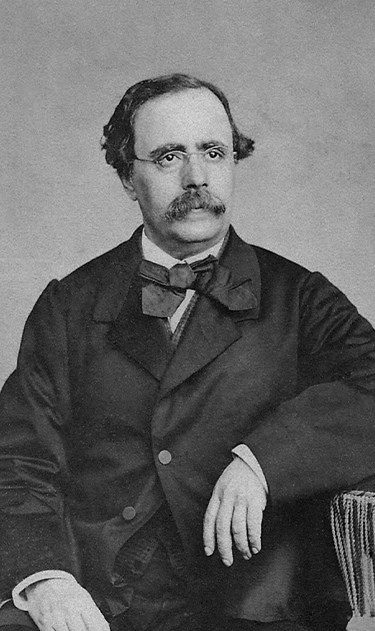Writer Antonio García Gutiérrez was born in Chiclana. He is one of the outstanding examples of Spanish romanticism. His production of songs and zarzuelas with composer Emilio Arrieta and the fact that Giuseppe Verdi chose two of his works as the basis of two emblematic operas, Il Trovatore and Simon Boccanegra, make him an undisputed benchmark of the connection between literature, theatre and music.
“Born in 1813, a few days and many kilometres apart, one in Busseto and the other in Chiclana de la Frontera, the destinies of musician Giuseppe Verdi and playwright Antonio García Gutiérrez would not only cross paths at a crucial moment in their lives, but the success of one also depended largely on the triumph of the other. Naturally, the Italian composer had an advantage when he focused on the writer from Chiclana when composing Il Trovatore and Simon Boccanegra, two operas from 1853 and 1857, based on the homonymous romantic dramas by García Gutiérrez that premiered in Madrid in 1836 and 1843″, writes José Ramón Ripoll.
Il Trovatore (The Troubadour) is an opera in four acts with music by Giuseppe Verdi and libretto in Italian by Salvatore Cammarano, based on the play of the same name, El Trovador (1836). Cammarano died months before the premiere and Verdi made some modifications to his first version, with help from the young librettist Leone Emanuele Bardare. The character of Leonora took on greater importance and presence, along with Azucena, the gypsy, who are among the core protagonists. If Azucena is revealed as the most original character of the set, Doña Leonor de Sesé, or Leonora, appears as a symbol of romantic love, faithful until death to her beloved Manrique.
Premiered on 19 January 1853 at the Teatro Apollo in Rome, Il Trovatore, along with Rigoletto and La Traviata, comprise the popular opera trilogy composed by Verdi in the middle of his career. There are differences between the operatic version and the original tragedy by García Gutiérrez, each based on different conceptions, one theatrical and one musical. In Verdi’s opera, the plot takes place between Biscay and Aragon during the revolt of Jaime de Urgel in the early 15th century against Fernando de Antequera, as a result of the Compromise of Caspe. In García Gutiérrez’s play, all the action takes place after the conflict. Cammarano and Bardare reduced the five original acts to four, also eliminating some characters such as Don Guillén and Don Lope de Urrea, Leonora’s brother and father, as well as several secondary characters whose roles are combined in a single servant, Ferrando, who was called Gimeno in the original play. Despite these alterations, the adaptation is quite faithful in spirit and plot.
Verdi chose to adapt another work by García Gutiérrez, Simón Bocanegra, which appeared in 1843. Years later, with the collaboration of Francesco María Piave, Giuseppe Montanelli and Arrigo Boito, it would premiere with great success.
In collaboration with Emilio Arrieta, García Gutiérrez wrote zarzuelas that were very popular in his time: Los alcaldes de Valladolid, La vuelta del Corsario, La mujer valerosa, El grumete, La espada de Bernardo, Azon Visconti, El robo de las sabinas, Dos coronas, El duende en palacio, Galán de noche, Cegar para ver, El capitán negrero, La taberna de Londres, Jonás Segundo, Un día de Reinado and his famous La Cacería real. With Arrieta he composed the hymn ¡Abajo los Borbones!,which would become the anthem of the Revolution of 1868, also called ‘La Gloriosa’.
